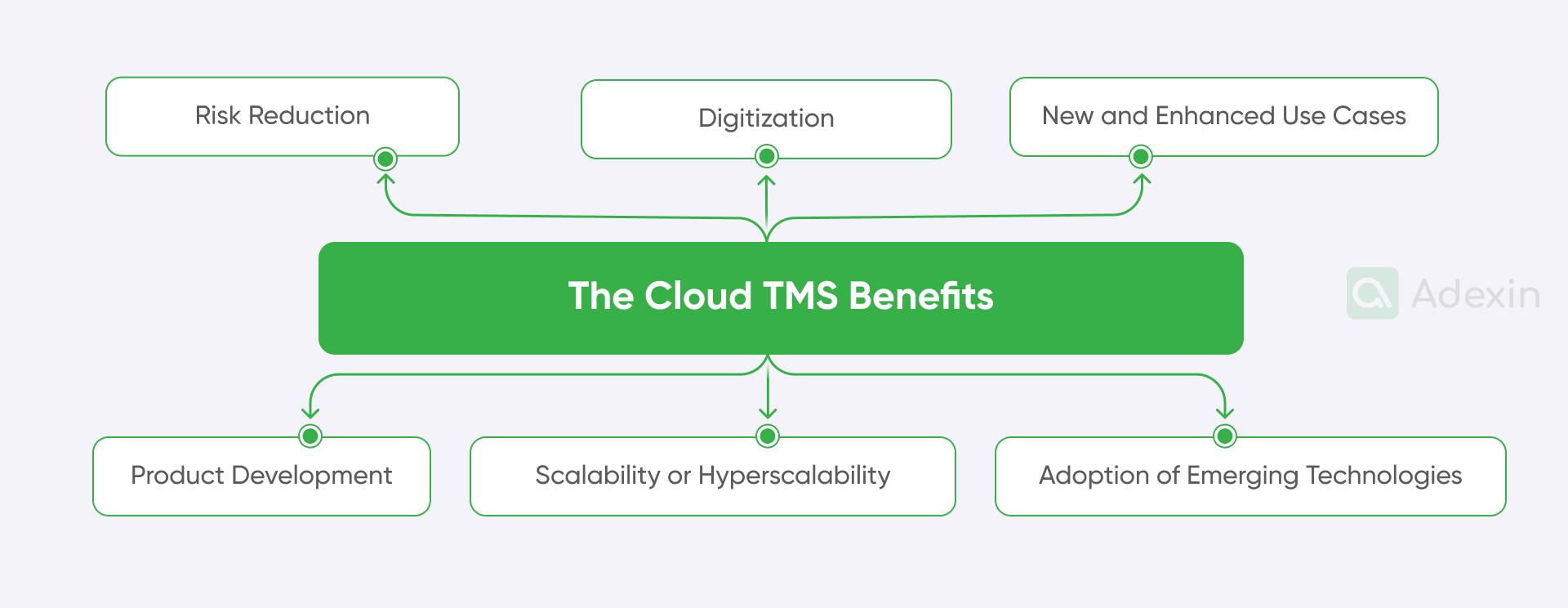Cloud transport management system is a well-known TMS solution, but this one is hosted and accessed through cloud architecture. Cloud based TMS solutions are highly scalable, and this brings many advantages for supply chain and transportation businesses. The cloud is a very agile solution that allows companies to easily adjust resource allocation based on changing needs. So, any time you want to narrow down your operations, such as increasing or decreasing storage capacity or processing power for transport management, you can do it easily with the cloud.
Referring to McKinsey's latest research “Cloud 2030”, we can give a direct example from the transport and logistics industry. For instance, a Danish company, a large container shipping line, used the cloud to build out new capabilities at 50% of the cost of on-premise TMS solutions. Their sole migration of 26 essential business applications reduced related OpEx by 10%. This is an insane advantage!
Considering this, we see that cloud solutions have huge potential, which increased even more during the COVID-19 pandemic. According to McKinsey's survey, 90% of respondents confirmed that cloud usage increased due to its flexibility, promoting more secure business operations during difficult economic times.
This article shares the cloud transport management systems architecture and its benefits. We also promote a custom-built TMS system developed for cloud architecture to help you understand how to achieve much more robust TMS solutions.
Cloud-based TMS: your way to agility and freedom
Cloud transportation management systems (TMS) have an untypical architecture that differs significantly from system installations on-premises. The logic of the cloud is straightforward when we think about transportation management systems on-premises, we know the system is installed on local servers. In contrast, cloud architecture shares data across multiple servers in various regions and countries. The data stream can be expanded or limited more quickly in the cloud because it depends on data migration within the cloud network. It is how it works, explained in the simplest terms. Later in this article, we will explore this topic in more detail, focusing more narrowly on both cloud and on-premises installations.
Here are the elements that compose cloud architecture:
Frontend platform for cloud TMS
The vast part of the cloud is the user-facing interface, such as web browsers or applications. These allow interaction with the cloud system much faster and seamlessly.
Backend platform built-in TMS
The underlying infrastructure, such as servers, storage, and databases, is much broader and truly powers cloud operations. Cloud solution-based custom software development can enable you to have even more extended capabilities good for freight forwarders, trucking businesses, and others.

Cloud storage
Cloud transportation management systems are a centralized repository for storing and managing data across various locations. So, you can still benefit from this practical function of on-premise installation, but you get a more scalable solution without over-investing in your infrastructure. Of course, you can still deploy the cloud on your own, but if we think cost-effectively, you can benefit from contracting it.
Network for logistics service providers
The cloud transportation management system is an interconnected system through the internet connection of servers and devices that enables seamless communication and data transfer. You deliver to your operation a very robust solution that makes everyday work for particular employees much easier.
Virtualization within TMS
The cloud transportation management systems (TMS) technology enables multiple virtual environments to operate on a single physical server, so, you don't need additional hardware. So, it is about optimizing resource usage in every area, whether we think about more effective planning or scheduling for your assets, fleet management of trucks, or even human resources.
Middleware
TMS software on the cloud is software that acts as an intermediary between different applications or services within the cloud environment. For example, application servers can handle requests and responses between applications, clients, and API gateways, control access to APIs, and manage traffic.
Security layers
TMS software cloud-based is embedded with modern encryption tools and protocols, which use cryptographic algorithms to protect data both in transit and at rest. Security is concerned not only with protecting against data breaches but also against data loss. Data loss prevention (DLP) protects sensitive data from leaving the cloud environment.
Custom cloud TMS: development experience from Adexin
Unlike off-the-shelf SaaS/COTS solutions or rigid low-code/no-code platforms, we created the Adexin Tools framework, that speeds up the development process and provides the flexibility to create a truly customized cloud based TMS. This is quite unmatched adaptability, enabling seamless integration of any required functionality. We cope with the latest developments to ensure the system adapts perfectly to unique business needs. All we do evolves with changing requirements, so we help you prepare for various business scenarios. Moreover, by leveraging standard and modern technologies, Adexin Tools simplifies development and reduces reliance on highly specialized talent which is also much more costly.
Here we deliver a few highlights of the key advantages of the Adexin Tools framework:
Flexibility and personalization. This concept emphasizes the ability to customize a TMS to meet specific needs. This is strictly opposed to off-the-shelf or limited platforms.
Control and evolution. This approach focuses on the user's ability to guide system development. It ensures that it meets future requirements.
Simplified development. The approach where we use Adexin Tools emphasizes the use of standard technologies. As a matter of fact, it reduces reliance on specialized skills and associated costs.
Need to speed up your development process?
Contact our tech expert to start
Explore moreThe cloud TMS benefits: value for small and medium-sized business
Nothing can translate the benefits of cloud architecture better than firm numbers based on intense research conducted by top industry leaders. McKinsey has prepared a brilliant overview for “Cloud 2030”, and based on their research, we've converted it into an outline of benefits. It is how we see companies in transportation management benefiting from cloud architecture by using TMS cloud.

Risk reduction with cloud TMS
It is clear that TMS software is reducing downtime. According to McKinsey's survey, migrated applications experience 57% less downtime due to lower incident frequency. Companies can also achieve faster recovery within cloud infrastructure when freight and transportation management data is exposed to risks. Another aspect of risk reduction is sparing money, where, due to lower breach costs, we see a 26% reduction due to enhanced security measures and robust data protection within the cloud. Platform integrity is a huge advantage within TMS software, where advancements reduce technological risks through automated security processes. You can oversee centralized security services and a modernized, consistent technology stack.
Digitization for TMS software operations
TMS cloud is accelerating digitization, which gives a boost to freight and transportation management organizations to swiftly implement modern solutions. These might relate to analytics-driven accounting and talent management systems. This digital transformation enables workforce upskilling. It is another point worth mentioning because it allows employees to repurpose and reskill to focus on higher-value activities. Furthermore, TMS software in the cloud can increase productivity by reducing manual effort facilitated by automation. There is no issue with API-based models or standardization across processes.
New and enhanced use cases
According to McKinsey, accelerated digitization facilitates a "fail-fast." This mentality enables rapid experimentation with new applications and business models at lower transportation costs. It reduces capital outlays by avoiding large upfront investments through the leverage of on-demand infrastructure. So, it is possible to get pay-as-you-go models. Furthermore, cloud solutions, such as TMS, enable new operating models. Transportation and freight companies can get support for shifts towards consumption-based models, demand forecasting, and improved logistics operations management with efficiency.
Much better product development
Cloud TMS can enhance agility in many fields. It increases the speed and efficiency of implementing use cases while reducing R&D investment. By using this, you can improve time-to-market. For example, you can invest in an MVP TMS cloud with custom development and get a robust solution for an affordable price and this is a great idea for a software demo today. Cloud provides access to innovative tools and capabilities like containers, microservices, DevOps, and CI/CD, which speed up product development cycles. And in the end, you can achieve smoother operations. Cloud TMS creates a more agile and responsive operating model that can adapt to changing business needs and streamline operations in logistics management.
Scalability or hyper scalability and integration
McKinsey says hyper scalability, but we like to have a balanced mood. For Adexin, we see cloud transportation management systems (TMS) as a scalable solution for your custom software development in transportation. You get global reach with the cloud, which enables rapid scaling of products to reach broader customer segments, geographies, and channels. Everything can be handled with on-demand elasticity. This approach provides TMS cloud instant access to flexible computing and storage capacity to support business growth and new ventures. TMS in the cloud can also integrate with order management, WMS systems, and others.
Adoption of emerging technologies
Cloud TMS enables proof-of-concept development by supporting the creation of agile teams to experiment with emerging technologies. These are within Adexin's scope of custom development, such as blockchain, AI, and VR. This environment attracts and retains top talent skilled in these emerging technologies, so it's much easier to cope with economic changes, such as COVID-19. Furthermore, it accelerates the adoption of these transformative technologies within the organization to grow customer satisfaction.
Are you in search of a reliable tech partner?
Adexin can help with advanced logistics solutions
Contact usFinale takeaway
Cloud transportation management systems (TMS) offer significant advantages over on-premises solutions. Leveraging cloud architecture can undoubtedly increase agility and scalability for businesses in the freight, transportation, and logistics industries.
If you're ready to unlock the full potential of your transportation or freight business, think agile with Adexin, your TMS provider, and enhance customer satisfaction with us. We specialize in developing tailored TMS solutions that leverage the power of cloud technology to drive efficiency. Our more than 10 years of experience help us achieve higher profitability and growth for our partners. An agile, cloud TMS system is a guarantee of better customer service.
Contact us today to discuss your needs and explore how a custom-built cloud TMS solution can revolutionize your operations.

